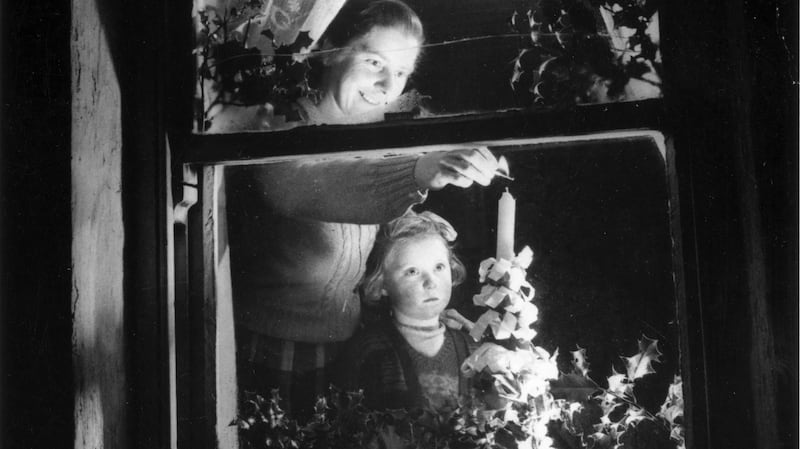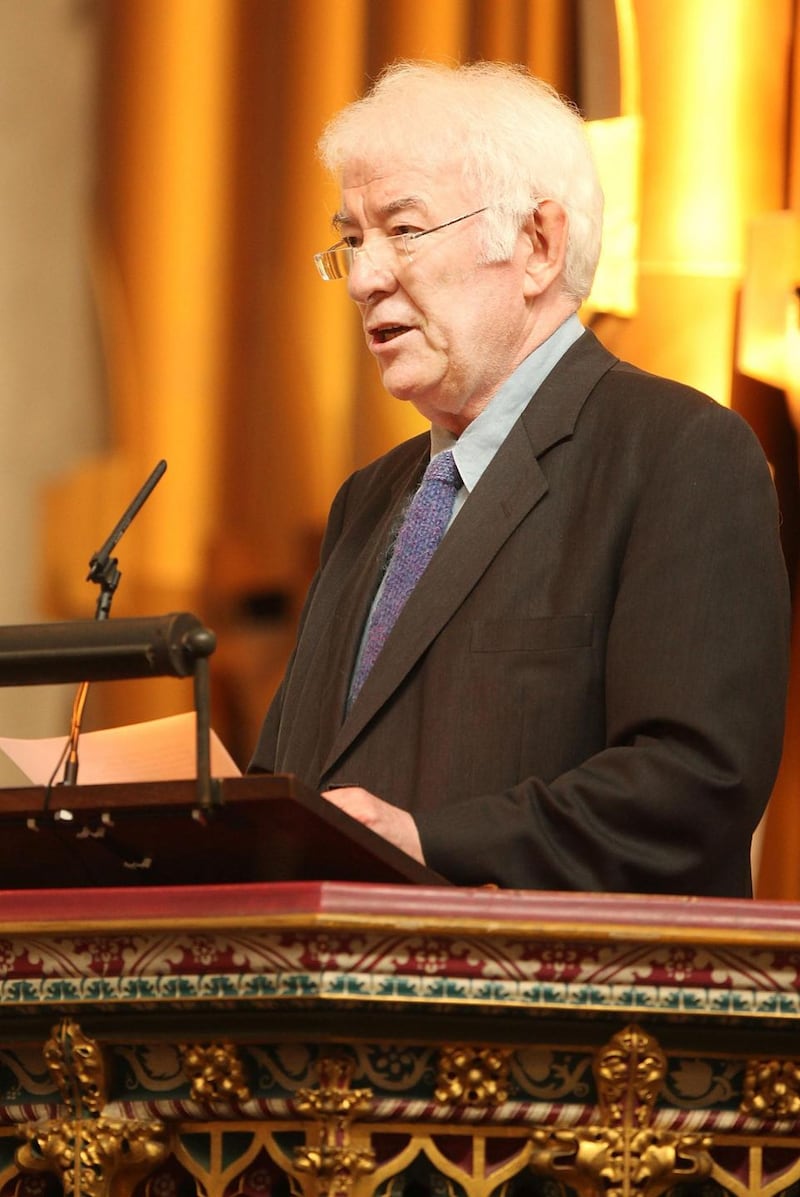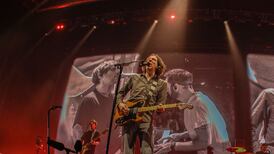In an interview with John Haffenden in 1981, Seamus Heaney describes religion as “part of the texture of growing up” and says his “whole life was permeated with it”. As he explains in a radio interview with John Quinn that was published in 1997, the habits of the household and of the nationalist population in Northern Ireland were “saturated in religious values”. These values contributed to those of his mother, he notes,and struck a profound chord with the “inner social bonding of the Catholic community”: the religious sensibility in him.
Catholicism, however, was only one strand in his spiritual heritage that he considered at length in a short piece in The Furrow in 1978. Strangely enough, there was nothing "specifically Christian" about his environment, though he felt that the whole place was imbued with a "sense of transcendental realities" and that these enjoyed "an active part" in his response to his home place. He perceived the landscape as "sacramental, a system of signs that called automatically upon systems of thinking and feeling". His whole environment offered "the foundation for a marvellous or magical view of the world, a foundation that sustained a diminished structure of lore and superstition and half-pagan, half-Christian thought and practice".
This foundation extended to the flora of the place, because much of this had a religious significance. The word “religion” means binding together and religious beliefs served as a community glue. The pagan and Christian were fused in this vision of the world. A thorn tree was associated with the world of the fairies, but the appearance of the Virgin Mary in this tree conferred on it a “new set of subliminal attributes”. Practices such as blessing water at Easter, lighting candles beside the beds of the dying, placing candles in windows at Christmas, genuflecting and making the sign of the cross countless times were part of the fabric of his upbringing that conferred a sense of never feeling “alone in the universe for a second” even as he “heard the clay hit the barefaced coffin”.

He believed that the poet who comes from a Catholic tradition is fortunate in having access to a feminine religious strain in religion. His mother, like the women of the time, identified with the Virgin because all endured the pain of child bearing. Her intercession was invoked by people in their troubles. As for his own sense of religion, he found that prayer was “enriched and nurtured” through invocation of the Virgin Mary. In an interview with Dennis O’Driscoll, he describes Catholicism as providing a “totally structured reading of the mortal condition” that he never succeeded in deconstructing. He felt that his “puny south Derry being” existed “within the great echoing acoustic of a universe of light and dark, death and everlasting life, divine praises and prayers for the dead”.
In another interview in the Sunday Telegraph in 2001, he affirms the value of a Catholic inheritance. A novelist might feel obliged to address the negative authoritarian aspect of its legacy, whereas Catholicism offers the poet a world "ashimmer" with possibilities and a sense of being part of an encounter with eternity where every thought and action are known to God.
Yet Heaney drifted away from the Catholic religious faith of his upbringing, though in a non-dramatic, low-key, almost light-touch manner. This movement from the faith of his childhood is described both in prose and in a poem entitled Like Everybody Else, from the Out of This World sequence. The prose account, which provides more detail than the poetic version, can be found in another interview with O'Driscoll. Here he speaks of bowing his head during the consecration of the Mass and of lifting his eyes at the elevation of the host and chalice. At the time, he believed that transubstantiation of the bread and wine into the body and blood of Christ had taken place, though he acknowledged the precise status of this belief was complex. After receiving the "mystery", he returned to his place, gave thanks, and then "felt time starting up again". He found the experience "phenomenally refreshing" and regretted that his faith was disappearing.
His loss of faith was not accompanied by high drama or deep philosophical musings, but, rather, it happened "offstage". There were, as Patrick Kavanagh wrote: "(n)o mad hooves galloping in the sky". Yet the potency of the words of the liturgy retained a hold on his imagination and he was unable to "disavow" their "tremor and draw". In the poem he refers to them as "well water far down". Unable to make an "act of faith", he explains in Station Island that he translated a poem of St John of the Cross to help his unbelief. The speaker of the poem exclaims in its last lines "I am repining for this living fountain/Within this bread of life I see it plain/although it is the night".
Heaney wondered if his willingness to live with the myths of his upbringing was rooted in his relationship with his mother, whose commitment he acquired as though through osmosis
So, unlike James Joyce, Heaney never felt the need to rebel angrily against the faith of his upbringing. As he explains to John Haffenden, he is impressed by the insights of anthropologists who have taught us about “living with our myths”. In the Quinn interview, he wonders if perhaps his qualified willingness to live with the myths of his upbringing was rooted in the close relationship with his mother, whose “fierce spiritual commitment” he acquired as though through a “process of osmosis from her spirit”.

Another reason for his wistfulness about this loss of faith was the association of Catholicism with the Irish culture of his home place. In the wonderful meditation, Among School Children, he tells readers that this inheritance ran deeply counter to the "official British culture" of the Unionist state. The state was an alien, colonial imposition that "was at odds with the anthropological culture" of where he grew up. An example of the latter, to be found in a little-known interview with graduate students in Trinity College in 1987, was learning prayers through Irish. This activity was part of the "cultural philosophical coherence" of the education that he received, and which was "on the whole – Catholic, Gaelic, nationalist".
Here too Heaney reflects on the connection between the Irish language and Catholicism. The language, he explains, marks “a confirmation of identity, of some kind of common piety within the nation and it relates strenuously... to a sectarian vision of the self in the North of Ireland”. He argues that “the Catholic disaffected political part linked itself to the vision of the lost Irish civilisation” and that Catholic schools provide a link to this civilisation. Religion and language are capillaries into an emotional and cultural inheritance. His sense of the preciousness of this legacy leads him to defend the role of separate Catholic schools in Northern Ireland.
At Christmas, the notion of God becoming human opens doors to imaginative resonances. It is a time to 'credit marvels' and a '(t)ime to be dazzled and the heart to lighten'
The reinforcing of Catholic identity was then important to Heaney, making of him a somewhat reluctant agnostic. Is it possible for such shy sceptics to join then in the celebration of Christmas? My answer is that it is, especially where Christianity is given expression in forms more spacious than in the cold doctrinal rigidity that has been condemned by Pope Francis himself. These forms are to be found in the generous, inclusive, non-defensive openness of many clergy and religious.
The following is an incident (I could recount many others) that reflects the kind of expansive religious attitude to Christmas that is compatible with the views expressed by Heaney and which would make of the church a home place for everyone. At a Mass during Advent in a local parish, the priest welcomed parishioners, visitors from outside the parish, visitors from other Christian and non-Christian faith traditions and visitors who did not believe in God but who wanted to be part of the community’s celebration. The church of many clergy is far from the institution of the sanctimonious brigade of militant lay Catholics, with their narrow-gauge version of the faith.
At Christmas, therefore, the notion of God becoming human opens doors to imaginative resonances that are beyond all telling. Like Heaney's poetry, these resonances prompt us to contemplate possibilities where "the spirit flares" and where there is no need to "waver/Into language" (from Squarings: Lightenings, in Seeing Things). It is a time to "credit marvels" and a "(t)ime to be dazzled and the heart to lighten" (from Fosterling).
Dr Kevin Williams is Senior Research Fellow at the Centre for Evaluation, Quality and Inspection, Institute of Education, Dublin City University



















